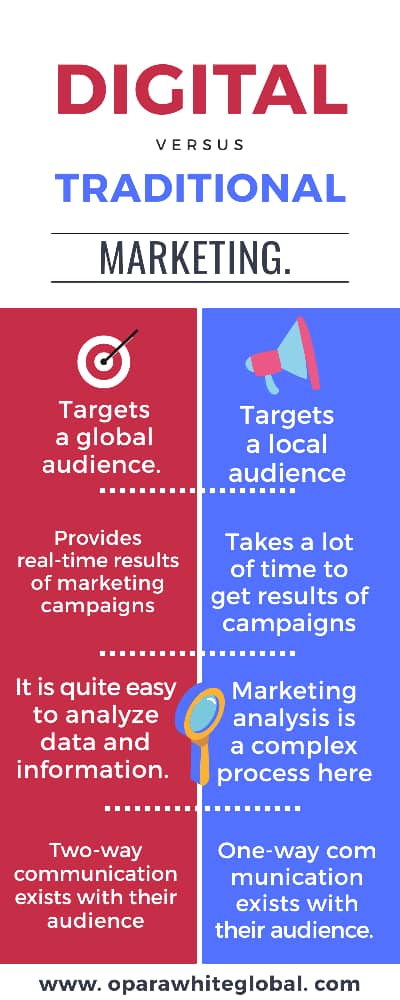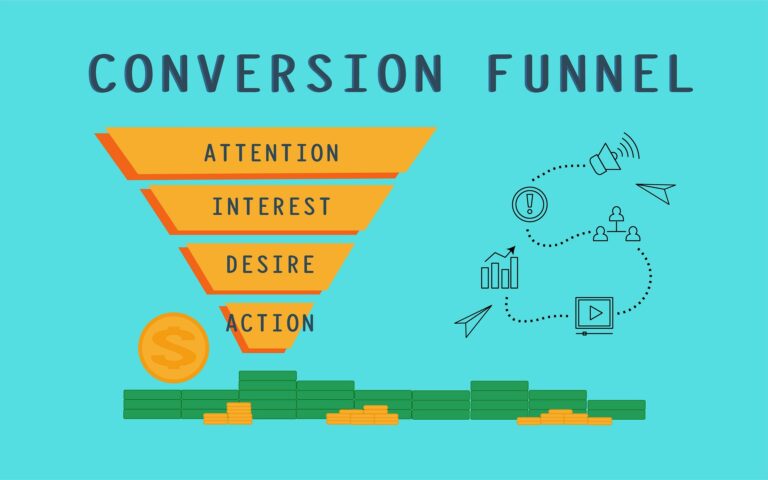For every business, marketing remains a branch that can not be ignored as it is the life wire of the business. Imagine creating a product without plans to market it, the product might as well be for the creator and his family. Marketing is getting the word out to the public about the availability of a product and most business both big and small set out marketing budgets for their business or brand.
Over the years, producers have been using the traditional mode of marketing to promote their products and services which have been working for them, but recently due to the trends in technology digital marketing is having an edge.
Traditional marketing is simply the marketing methods we have been used to over the years and it comes under the following categories,
- Print (Newspapers and magazines)
- Outdoor ( Billboards, posters, etc)
- Broadcasting (Tv, Radio, etc)
- Direct mails (Catalogues etc)
- Telemarketing (Phone and text message)
Traditional marketing was very much the only type of marketing available up until the development of the internet in the 1990s.
Digital marketing is simply the use of the internet to market your products, and the channel includes google ads, social media marketing, email marketing, etc.
Having a promising market for your products is commendable but having the right marketing strategy is the bomb. The key to having the right marketing strategy is to learn how to strike a balance between traditional and digital marketing. This is because inasmuch as traditional marketing may seem outdated, it is still relevant as there is a percentage of people who are skeptical about making transactions online and each of them has its own pros and cons.
Questions that come up in the minds of marketers are which marketing channel to use for their business though this depends on the product and target audience. On that note, we will be analyzing the pros and cons of the two types of marketing to help you make a better decision.
- Targeting: Traditional marketing is limited in terms of the targeted audience as it is limited to local customers whereas digital marketing grabs the attention of customers globally and thus can reach a wider audience. According to statistics, more than 80% of shoppers do their research online before making a purchase, and with digital marketing, companies position themselves in front of their target audience.
Using a magazine or newspaper advert as an example, not all audiences who patronize a newspaper brand may be interested in the product being advertised, as well as not all the company’s audience may also patronize the newspaper brand. This leaves a number of audiences not seeing the product advert, but with digital marketing, targeting a specific audience is highly possible and it brings your product right in front of your target audience.
- Realtime Results: Digital Marketing provides real-time marketing results that helps the company restrategize their marketing methods in order to generate maximum revenue. With traditional marketing, the company has to wait weeks to get the result of its marketing campaigns or methods, for this reason, drafting marketing strategy takes time as it depends on the results of previous marketing. In addition to this waste of time, it is also not easy to measure the results efficiently and in-depth to ensure you are not investing in the wrong place.
Contrary to traditional marketing, digital marketing provides exceptionally in-depth results of the marketing and this makes digital marketing more preferable for marketers since it saves their time and helps them make the right marketing investments.
- Higher Costs: Consistency is paramount to achieve results in all marketing channels in order to stay top of mind. For digital marketing, it doesn’t take much to continue putting up content on your business website or social media page. Running paid ads consistently for a period of time won’t cost as much as advertising on a Tv channel or newspapers for the same time and even that is optional.
- Marketing Analysis: Result analysis is quite complex with traditional marketing since the brands have to rely on market surveys and research for information. However, in online marketing data is very much available and facts are recorded and stored online which makes it easier for the brands to get the information they need and make better decisions. For example, according to ClickZ, “Internet users now make up 57% of the global population. On average people spend 6hours and 42minutes online each day. By 2021, a projected 73% of all eCommerce sales will come from mobile”. With data like this, a company or brand is equipped to make wise decisions and channel their efforts towards the right source.
- Consumer Interaction: In digital marketing, customer interaction is easier to maintain and it promotes two-way communication between the customers and the brand. The customer can easily speak their minds and be listened to, this also helps the brand to understand the minds of the customers, how they feel about the brand and what their pain points are to enable them to do a better job. In traditional marketing, it is one-way communication and the interaction mediums are quite stiff, as a brand you are more or less in the dark about the effects of your marketing efforts.
The 4 P’s of marketing; Product, Price, Place, and Promotion relates to both aspects of marketing in their unique and different ways.
Price: The pricing of a product is dependent on the cost of production and the cost of getting the product to the market. For eMarketing sites and other online marketing methods, the probability of saving costs is higher and therefore the possibility of lower prices. Internet-based marketing sites use a cheap mode of communication like email and competition is also very tough as the competitors are a click away while a potential customer is searching for information.
Product: Having a good understanding of your own product is what begins effective marketing. Most customers would prefer to get a feel of products before purchase but digital marketing does not give them that privilege. That is why they would feel a lot safer to spend on products with a warranty or better still purchase from a physical store. Traditional marketing provides face to face contact with customers which is not so in digital marketing. But then digital marketing provides facilities like emails, FAQs, so as to be more responsive to customers.
Place: The Internet helps companies to be available 24/7 unlike opening hours that physical stores require. Also, this helps to reach a wider audience. In the world of marketing, place plays an essential role. When a product is placed in the right location, it is able to bring in more returns and conversions. Traditional marketing tries to achieve this by using the channels and data available, while digital marketing also does the same by targeting the right people.
Little wonder, there is a high chance of seeing an ad about a travel agency if you have just previously googled about traveling.
Promotion: Digital marketing heavily relies on promotion while using the other p’s of marketing in a unique way. Promotion is simply getting word about your product to the public or targeted audience. In digital marketing, a company is able to put up all the various offers regarding its product including discount offers on its website and other media pages. A magazine ad may not be able to contain all of this.
What if after publishing a newspaper or magazine containing an ad, and it happens that there was a mistake or that there are a few updates to make on the product or its offer? Nothing can be done to change it, especially if copies have already been made. But with digital marketing, updates are just a few clicks away.
Both traditional marketing and digital marketing are relevant depending on the kind of product. While traditional marketing may seem old-fashioned, it is relevant and if used wisely would also generate great returns. For companies who can afford both, learning how to balance the use of each would definitely create that trust with your customers.
With the points above it is obvious that digital marketing is gaining an upper hand in the marketing industry compared to traditional marketing. The shift in trend is clear and is happening at a very fast pace, it would be wise to embrace technology and continue to evolve your business so as to remain in front of your competitors.




